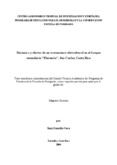| dc.contributor.author | Guardia Vaca, Susy | |
| dc.date.accessioned | 2014-10-20T04:41:18Z | |
| dc.date.available | 2014-10-20T04:41:18Z | |
| dc.date.issued | 2004 | es_ES |
| dc.identifier | 366622 | es_ES |
| dc.identifier.uri | https://repositorio.catie.ac.cr/handle/11554/4824 | |
| dc.description | Tesis (M. Sc) -- CATIE, Turrialba (Costa Rica), 2004 | es_ES |
| dc.description | 110 páginas | |
| dc.description | 4 ilus. 31 tab. | |
| dc.description | Referencias 103-110 | |
| dc.description.abstract | En el año 2003, en el bosque húmedo tropical secundario Florencia, San Carlos, Costa Rica, se realizó una evaluación de 14 parcelas permanentes (PPM) de 40 m x 60 m (0.24 ha). El primer componente del estudio pretendió caracterizar la dinámica del rodal en términos de la composición florística y riqueza de especies, así como la dinámica de especies individuales y el crecimiento en diámetro, comparando los dos tipos de bosque. El segundo componente del estudio pretendió caracterizar el efecto del tratamiento silvicultural sobre la dinámica del rodal y de especies individuales así como el crecimiento en diámetro. Los resultados indican que hubo efecto del tratamiento sobre la dinámica poblacional y el incremento en diámetro a nivel de rodal tratado. Sin embargo, no fue significativo el efecto sobre el crecimiento de los árboles para la futura cosecha. Se concluye que ese tipo de intervención silvicultural en bosques secundarios en la tercera etapa de la sucesión no es recomendable por los altos costos de la intervención que no son recompensados por el aumento en el crecimiento diamétrico de árboles de especies. | es_ES |
| dc.description.abstract | In 2003, 14 permanent sample plots (PSP) of 40 m x 60 m each (0.24 ha) were measured in the tropical secondary forest Florencia, San Carlos, Costa Rica. The first component of the study sought to characterize the stand dynamics in terMON of floristic composition and species richness, as well as the dynamics of individual species and diameter growth, comparing the two forest types. The second component aimed at characterizing the effect of the silvicultural treatment on stand dynamics, the dynamics of individual species, and diameter growth. The results reveal the effect of the silvicultural treatment on population dynamics and diameter growth at the level of the treated stand. However, the effect was not significant on the growth of future crop trees. It is concluded that this type of silvicultural intervention in secondary forests of the third succession phase is not recommendable in view of the high costs that are not compensated for by the increase in diameter growth of the commercial tree species. | |
| dc.language.iso | es | es_ES |
| dc.publisher | CATIE, Turrialba (Costa Rica) | es_ES |
| dc.subject | SILVICULTURE | |
| dc.subject | FORESTRY OPERATIONS | |
| dc.subject | BIODIVERSITY | |
| dc.subject | GROWTH RATE | |
| dc.subject | BREAST HEIGHT DIAMETER | |
| dc.subject | FOREST MENSURATION | |
| dc.subject | VOLUME TABLES | |
| dc.subject | TROPICAL RAIN FORESTS | |
| dc.subject | SECONDARY FORESTSCOSTA RICA | |
| dc.subject | CORDIA ALLIODORA | |
| dc.subject | SILVICULTURA | |
| dc.subject | OPERACIONES FORESTALES | |
| dc.subject | BIODIVERSIDAD | |
| dc.subject | INDICE DE CRECIMIENTO | |
| dc.subject | DIAMETRO A LA ALTURA DE PECHO | |
| dc.subject | DENDROMETRIA | |
| dc.subject | TABLAS DE CUBICACION | |
| dc.subject | BOSQUE TROPICAL HUMEDO | |
| dc.subject | BOSQUE SECUNDARIO | |
| dc.title | Dinámica y efectos de un tratamiento silvicultural en el bosque secundario Florencia, San Carlos, Costa Rica | es_ES |
| dc.title.alternative | Dynamics and effects of a silvicultural treatment in the secondary forest Florencia, San Carlos, Costa Rica | es_ES |
| dc.type | Tesis de maestría | es_ES |
| dcterms.rights | acceso abierto | es_Es |
| dc.identifier.publication | Turrialba (Costa Rica) | es_ES |


